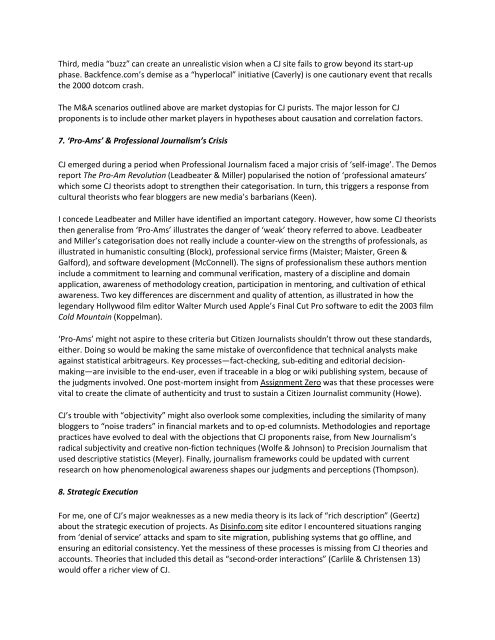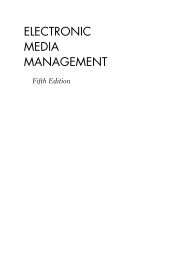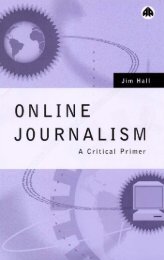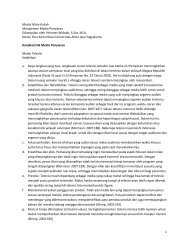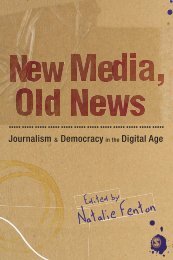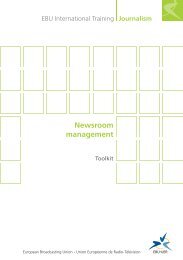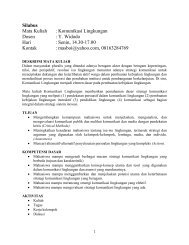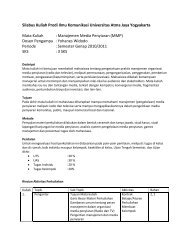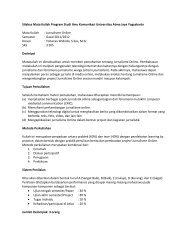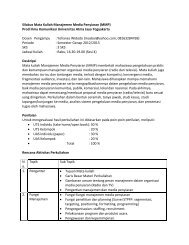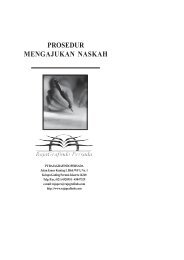Modul Mata Kuliah Journalisme Online - Ayo Menulis FISIP UAJY
Modul Mata Kuliah Journalisme Online - Ayo Menulis FISIP UAJY
Modul Mata Kuliah Journalisme Online - Ayo Menulis FISIP UAJY
You also want an ePaper? Increase the reach of your titles
YUMPU automatically turns print PDFs into web optimized ePapers that Google loves.
Third, media “buzz” can create an unrealistic vision when a CJ site fails to grow beyond its start-up<br />
phase. Backfence.com’s demise as a “hyperlocal” initiative (Caverly) is one cautionary event that recalls<br />
the 2000 dotcom crash.<br />
The M&A scenarios outlined above are market dystopias for CJ purists. The major lesson for CJ<br />
proponents is to include other market players in hypotheses about causation and correlation factors.<br />
7. ‘Pro-Ams’ & Professional Journalism’s Crisis<br />
CJ emerged during a period when Professional Journalism faced a major crisis of ‘self-image’. The Demos<br />
report The Pro-Am Revolution (Leadbeater & Miller) popularised the notion of ‘professional amateurs’<br />
which some CJ theorists adopt to strengthen their categorisation. In turn, this triggers a response from<br />
cultural theorists who fear bloggers are new media’s barbarians (Keen).<br />
I concede Leadbeater and Miller have identified an important category. However, how some CJ theorists<br />
then generalise from ‘Pro-Ams’ illustrates the danger of ‘weak’ theory referred to above. Leadbeater<br />
and Miller’s categorisation does not really include a counter-view on the strengths of professionals, as<br />
illustrated in humanistic consulting (Block), professional service firms (Maister; Maister, Green &<br />
Galford), and software development (McConnell). The signs of professionalism these authors mention<br />
include a commitment to learning and communal verification, mastery of a discipline and domain<br />
application, awareness of methodology creation, participation in mentoring, and cultivation of ethical<br />
awareness. Two key differences are discernment and quality of attention, as illustrated in how the<br />
legendary Hollywood film editor Walter Murch used Apple’s Final Cut Pro software to edit the 2003 film<br />
Cold Mountain (Koppelman).<br />
‘Pro-Ams’ might not aspire to these criteria but Citizen Journalists shouldn’t throw out these standards,<br />
either. Doing so would be making the same mistake of overconfidence that technical analysts make<br />
against statistical arbitrageurs. Key processes—fact-checking, sub-editing and editorial decisionmaking—are<br />
invisible to the end-user, even if traceable in a blog or wiki publishing system, because of<br />
the judgments involved. One post-mortem insight from Assignment Zero was that these processes were<br />
vital to create the climate of authenticity and trust to sustain a Citizen Journalist community (Howe).<br />
CJ’s trouble with “objectivity” might also overlook some complexities, including the similarity of many<br />
bloggers to “noise traders” in financial markets and to op-ed columnists. Methodologies and reportage<br />
practices have evolved to deal with the objections that CJ proponents raise, from New Journalism’s<br />
radical subjectivity and creative non-fiction techniques (Wolfe & Johnson) to Precision Journalism that<br />
used descriptive statistics (Meyer). Finally, journalism frameworks could be updated with current<br />
research on how phenomenological awareness shapes our judgments and perceptions (Thompson).<br />
8. Strategic Execution<br />
For me, one of CJ’s major weaknesses as a new media theory is its lack of “rich description” (Geertz)<br />
about the strategic execution of projects. As Disinfo.com site editor I encountered situations ranging<br />
from ‘denial of service’ attacks and spam to site migration, publishing systems that go offline, and<br />
ensuring an editorial consistency. Yet the messiness of these processes is missing from CJ theories and<br />
accounts. Theories that included this detail as “second-order interactions” (Carlile & Christensen 13)<br />
would offer a richer view of CJ.


